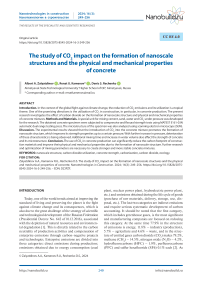The study of CO2 impact on the formation of nanoscale structures and the physical and mechanical properties of concrete
Автор: Zalyatdinov A.A., Kamenov R.U., Rechenko D.S.
Журнал: Nanotechnologies in Construction: A Scientific Internet-Journal @nanobuild-en
Рубрика: The results of the specialists’ and scientists’ researches
Статья в выпуске: 3 Vol.16, 2024 года.
Бесплатный доступ
Introduction. In the context of the global fight against climate change, the reduction of CO2 emissions and its utilization is a topical theme. One of the promising directions is the utilization of CO2 in construction, in particular, in concrete production. The present research investigates the effect of carbon dioxide on the formation of nanoscale structure and physical and mechanical properties of concrete mixtures. Methods and Materials. A special unit for mixing cement, sand, water and CO2 under pressure was developed for the research. The obtained concrete specimen were subjected to compressive and flexural strength tests using MATEST E161-03N automatic dual range testing press. The microstructure of the specimen was also analyzed using scanning electron microscope (SEM). Discussion. The experimental results showed that the introduction of CO2 into the concrete mixture promotes the formation of nanoscale structure, which improves its strength properties up to a certain pressure. With further increase in pressure, deterioration of these characteristics is being observed. Additional mixing time and increase in water volume also affect the strength of concrete and its microstructure. Conclusion. The use of CO2 in concrete production can significantly reduce the carbon footprint of construction materials and improve their physical and mechanical properties due to the formation of nanoscale structure. Further research and optimization of mixing parameters are necessary to create stronger and more stable concrete mixtures.
Nanoscale structure, carbon dioxide utilization, concrete strength, carbonization, carbon dioxide, ecology
Короткий адрес: https://sciup.org/142240870
IDR: 142240870 | DOI: 10.15828/2075-8545-2024-16-3-249-256
Список литературы The study of CO2 impact on the formation of nanoscale structures and the physical and mechanical properties of concrete
- Kondratyev V.B. World cement industry. V.B. Kondratyev. Industries and sectors of the global economy: features and trends of development. Foundation for Historical Perspective Center for Research and Analysis. – Moscow : International Relations Publishing House; 2015 185-202.
- Kline D. Designing a cement plant of the future. Part II. D. Kline. Cement and its applications. 2019; 1: 48-53.
- Monteiro, P.J.M. Towards sustainable concrete. P.J.M. Monteiro, S.A. Miller, A. Horvath. Nature Mater. 2017;16 (7):698-699.
- Gartner E.M. A physico-chemical basis for novel cementitious binders. E.M. Gartner, D.E. Macphee. Cement and Concrete Research. 2011; 41(7): 736-749.
- Cement technology roadmap [Electronic resource]. Mode of access: https://www.wbcsd.org/Sector-Projects/Cement-Sustainability-Initiative/News/Cement-technology-roadmap-shows-how-the-path-to-achieve-CO2-reductions-up-to-24-by-2050. Date of access: 21.01.2024.
- Evans L. Environmental rating of cement. L. Evans, M. Mutter. Cement and its application. 2019; 4: 24-27.
- Meyer V. Properties of Solidia Cement and Concrete. V. Meyer, S. Sahu, A. Dunster. Proceedings of the 1st International Conference on Innovation in Lowcarbon Cement & Concrete Technology London, UK; 2019. 24-26.
- 1st International Conference on Innovation in Low Carbon Cement and Concrete Technology. R. Mangabhai [et al]; 2019. 103
- Boden T. Global, Regional, and National Fossil-Fuel CO2 Emissions (1751 - 2014) (V. 2017). T. Boden, R. Andres, G. Marland. 2017.
- Cement and carbon emissions. L. Barcelo [et al.]. Mater Struct. 2014; 47(6); 1055-1065.
- Andrew R.M. Global CO2 emissions from cement production. R.M. Andrew. Earth Syst. Sci. Data. 2018;10(1):195-217.
- Leber I. Some effects of carbon dioxide on mortars and concrete. I. Leber, F.A. Blakey. Mater. construcc. 2017;7 (079): 39.
- Shmitko E.I. Chemistry of cement and binding agents. E.I. Shmitko, A.V. Krylov, V.V. Shatalov. Shatalov. Voronezh: Voronezh State University of Architecture and Civil Engineering; 2005. 164
- Scrivener K.L. Options for the future of cement. K.L. Scrivener. 2014; (88)7:11-21.
- Neville A.M. Properties of concrete. A.M. Neville. M.: Stroyizdat;1972. 269-271.
- Katz A. Properties of concrete made with recycled aggregate from partially hydrated old concrete. A. Katz. Cement and Concrete Research. 2003;33(5):703-711.
- Kosmatka S.H. Design and control of concrete mixtures. S.H. Kosmatka, B. Kerkhoff, W.C. Panarese. – Skokie, Ill: Portland Cement Association 2002. 358.
- Neville A.M. Concrete technology. A.M. Neville, J.J. Brooks. Harlow: Prentice Hall 2010; 442.
- Day K.W. Concrete mix design, quality control and specification. K.W. Day. London: E & FN Spon; 1999. 391.
- Woodson R.D. Concrete structures: protection, repair and rehabilitation. Concrete structures. R.D. Woodson. Amsterdam; Boston: Butterworth-Heinemann; 2009. 255
- Handbook of concrete engineering. ред. M. Fintel. New York: Van Nostrand Reinhold; 1985. 892
- Mehta P.K. Concrete: microstructure, properties, and materials. Concrete. P.K. Mehta, P.J.M. Monteiro. – New York: McGraw-Hill Education; 2014. 675.
- Palley R. Concrete: a seven-thousand-year history. Concrete. R. Palley. New York: The Quantuck Lane Press; 2010. 232.
- Courland R. Concrete planet: the strange and fascinating story of the world’s most common man-made material. Concrete planet. R. Courland. Amherst NY: Prometheus Books; 2011. 396.
- The new concrete: visual poetry in the 21st century. The new concrete. ред. V. Bean C. McCabe, K. Goldsmith. London: Hayward Publ; 2015. 240.
- Forty A. Concrete and culture: a material history. Concrete and culture. A. Forty. – London: Reaktion 2012.
- Collins P. Concrete: the vision of a new architecture. Concrete. P. Collins. – Montréal: McGill-Queen’s University Press; 2004. 64.
- GOST 10180-2012 Concretes. Methods of determination of strength by control samples.


